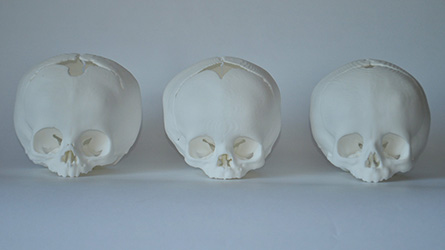AnatomikModeling worked on 3D printing of babies’ skulls. Those 3D printing were used to train paediatrician by Professor Guillaume Captier during the “Perinatal news day” organised by the study group in neonatalogy from Languedoc-Roussillon (France).
From those scanner data, AnatomikModeling generated 3D models in high definition of the bones of three six month old babies’ skulls, to realise the 3D printings.
 "Plagiocephaly, also named “flat head syndrome” is a positional distortion from the skull of new borns. During the clinical examination, the paediatrician has to remove a craniosynostosis before prescribing a physiotherapy treatment. The skull examination can be hard and the possibility to have distorted skulls models is a major advantage for the understanding of the clinical examination. A 3D printing of three skulls has been done at a 6 months old baby’s scale, each of them representing a type of positional distortion (fronto-occipital plagiocephaly, occipital plagiocephaly and posterior brachycephaly). The experiment of those 3D models by paediatricians helps along the understanding of the clinical examination to do the diagnosis of distortion and get rid of a craniosynostosis. During the “Perinatal news day” of the study group of neonatalogy, this method has been tested in the workshop: Lying directly after birth. Lying on the back, risk factor of the positional plagiocephaly?”
"Plagiocephaly, also named “flat head syndrome” is a positional distortion from the skull of new borns. During the clinical examination, the paediatrician has to remove a craniosynostosis before prescribing a physiotherapy treatment. The skull examination can be hard and the possibility to have distorted skulls models is a major advantage for the understanding of the clinical examination. A 3D printing of three skulls has been done at a 6 months old baby’s scale, each of them representing a type of positional distortion (fronto-occipital plagiocephaly, occipital plagiocephaly and posterior brachycephaly). The experiment of those 3D models by paediatricians helps along the understanding of the clinical examination to do the diagnosis of distortion and get rid of a craniosynostosis. During the “Perinatal news day” of the study group of neonatalogy, this method has been tested in the workshop: Lying directly after birth. Lying on the back, risk factor of the positional plagiocephaly?”
Pr Guillaume Captier, Plastic and pediatric surgeon

